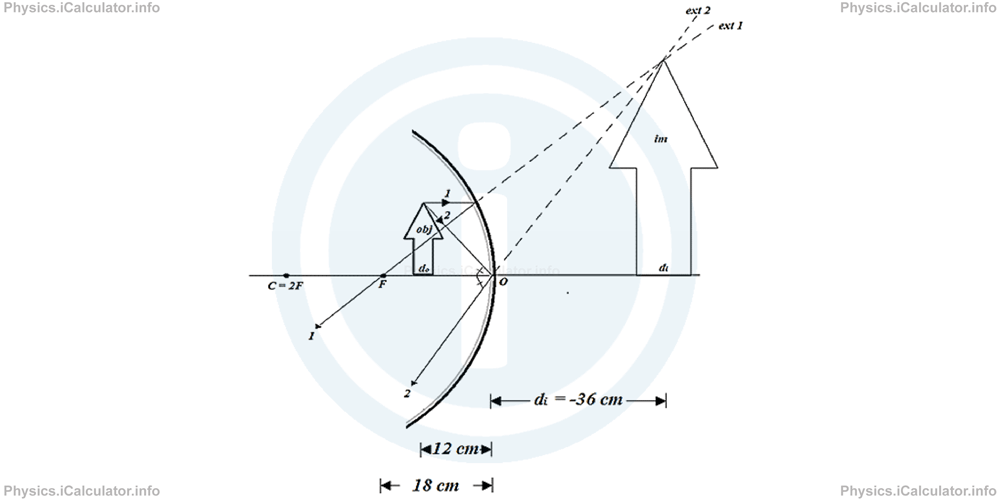Menu
Physics Lesson 12.8.6 - Equation of Curved Mirrors
Please provide a rating, it takes seconds and helps us to keep this resource free for all to use
Welcome to our Physics lesson on Equation of Curved Mirrors, this is the sixth lesson of our suite of physics lessons covering the topic of Mirrors. Equation of Curved Mirrors. Image Formation in Plane and Curved Mirrors, you can find links to the other lessons within this tutorial and access additional physics learning resources below this lesson.
Equation of Curved Mirrors
There is an equation that provides the numerical relationship between the object's distance do, image distance dî and focal length (focus) F, which allows us to determine the position of image without having need for drawings. This equation (known as the Equation of Curved Mirrors) is
However, this is not that simple; not always all values are positive. Thus, we need to correctly apply the sign rules if we want to avoid mistakes in the position values. These rules are provided below.
- The object's position do is always taken as positive.
- In concave mirrors, the focal length F is taken as positive while in convex mirrors it is taken as negative.
- If the image is real, its position dî is taken as positive, while if the image is virtual its distance dî is taken as negative.
Example 2
An object is placed 12 cm in front of a concave mirror of focal length equal to 18 cm.
- What are the image features for this case?
- What is the position of image formed in this mirror?
Solution 2
- From the given values, it is clear that the image is formed nearer to the concave mirror than focus. Therefore, this situation represents the fifth case of image formation in concave mirrors. It means the image is virtual, erect and enlarged.
- We have the following clues based on the description and the sign rules of image formation in curved mirrors.
f = 18 cm
d1 = ?
Applying the mirror equation
we obtain after substitutions
1/dî= 1/18 - 1/12
= 2/36 - 3/36
= - 1/36
Therefore, the position of image is dî = -36 cm. This means it is formed at 36 cm behind the mirror, as shown in the figure below.

You have reached the end of Physics lesson 12.8.6 Equation of Curved Mirrors. There are 8 lessons in this physics tutorial covering Mirrors. Equation of Curved Mirrors. Image Formation in Plane and Curved Mirrors, you can access all the lessons from this tutorial below.
More Mirrors. Equation of Curved Mirrors. Image Formation in Plane and Curved Mirrors Lessons and Learning Resources
Whats next?
Enjoy the "Equation of Curved Mirrors" physics lesson? People who liked the "Mirrors. Equation of Curved Mirrors. Image Formation in Plane and Curved Mirrors lesson found the following resources useful:
- Curved Feedback. Helps other - Leave a rating for this curved (see below)
- Optics Physics tutorial: Mirrors. Equation of Curved Mirrors. Image Formation in Plane and Curved Mirrors. Read the Mirrors. Equation of Curved Mirrors. Image Formation in Plane and Curved Mirrors physics tutorial and build your physics knowledge of Optics
- Optics Revision Notes: Mirrors. Equation of Curved Mirrors. Image Formation in Plane and Curved Mirrors. Print the notes so you can revise the key points covered in the physics tutorial for Mirrors. Equation of Curved Mirrors. Image Formation in Plane and Curved Mirrors
- Optics Practice Questions: Mirrors. Equation of Curved Mirrors. Image Formation in Plane and Curved Mirrors. Test and improve your knowledge of Mirrors. Equation of Curved Mirrors. Image Formation in Plane and Curved Mirrors with example questins and answers
- Check your calculations for Optics questions with our excellent Optics calculators which contain full equations and calculations clearly displayed line by line. See the Optics Calculators by iCalculator™ below.
- Continuing learning optics - read our next physics tutorial: Lenses. Equation of Lenses. Image Formation of Lenses
Help others Learning Physics just like you
Please provide a rating, it takes seconds and helps us to keep this resource free for all to use
We hope you found this Physics lesson "Mirrors. Equation of Curved Mirrors. Image Formation in Plane and Curved Mirrors" useful. If you did it would be great if you could spare the time to rate this physics lesson (simply click on the number of stars that match your assessment of this physics learning aide) and/or share on social media, this helps us identify popular tutorials and calculators and expand our free learning resources to support our users around the world have free access to expand their knowledge of physics and other disciplines.